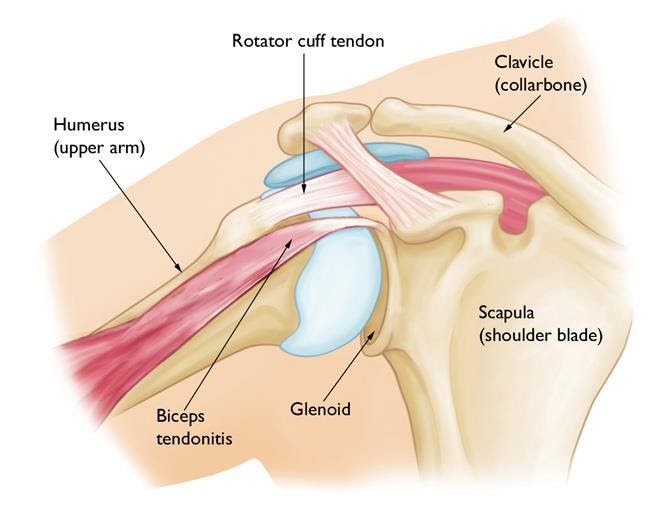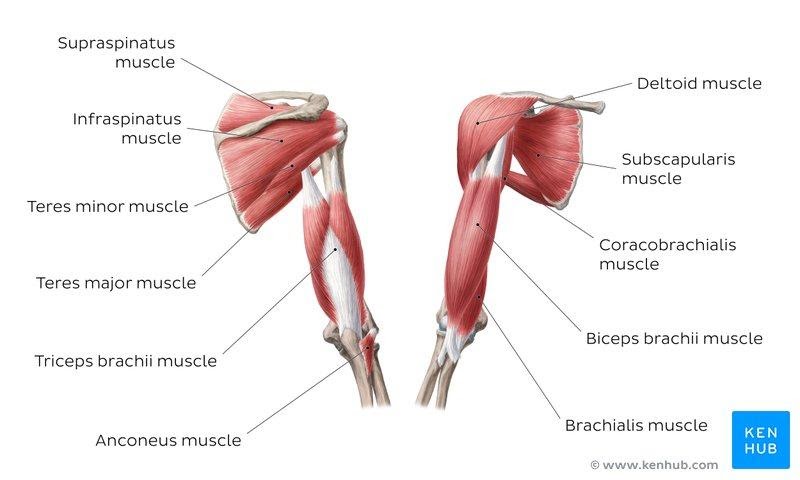Biceps Tendonitis
What is Biceps Tendonitis?
Tendonitis is an inflammatory condition that affects tendons (Tissue that connects muscle to bone) that causes pain and swelling to occur in the impacted tendon. Any tendon is at risk for developing tendonitis, but one of the most commonly affected is the long head of the biceps tendon in the shoulder. Tendonitis is typically considered an overuse injury that is caused by weakness and/or faulty movement patterns. Other typical causes for bicep tendonitis include rotator cuff tears, shoulder laxity (Looseness), shoulder tightness, an abrupt increase in exercise or activity, or age-related changes in the body.
Due to the location of the bicep tendon, it is often associated with other common shoulder pathologies such as rotator cuff tears, shoulder impingement, bursitis, and labral tears. 95% of people with bicipital tendonitis also suffer from a related shoulder pathology.
Anatomy: There is a complex interaction that occurs in the shoulder to ensure that when you move your arm, the shoulder moves appropriately and does not compress any of the underlying structures. When this interaction does not occur, the humerus (arm) can move excessively in the glenoid (shoulder) and result in unwanted rubbing and compression of the tendons and other soft structures in the shoulder.
- Bones: The largest joint of the shoulder is the glen humeral joint (GHJ) made from the humeral head of the arm and the glenoid fossa of the shoulder blade. These two bones are connected by many ligaments and muscles and allow for a wide range of motion. The coracoid process is a boney projection in the front of the shoulder that serves for the attachment site of various muscles and ligaments. Another important joint is the acromioclavicular joint (ACJ) which is formed by the clavicle (collar bone) and the acromion of the shoulder blade (boney prominence on the top of your shoulder). This is an important joint as it is the ‘roof’ of the shoulder.
- Tendons and Ligaments:
- Tendons are at the ends of muscles to attach them to the bone. The long head of the biceps brachia originates within the shoulder joint. The other tendon that can be implicated with biceps tendinitis is the supraspinatus tendon- a rotator cuff muscle.
- The glenoid is covered in a soft tissue called a labrum to allow for better fit and movement of the humorous, this is also where the long head of the bicep tendon originates.
- Around the GHJ multiple ligaments connect the humorous to the glenoid and shoulder blade. A few that may be impacted in bicep tendonitis include: Coracoacromial (Attaches coracoid and acromion), and the Glen humeral Ligaments that gives the shoulder stability.
- Other important areas are the joint capsule that surrounds the GHJ, which provides for passive stability and keeps the shoulder stable.
- Muscles: While there are many muscles that control I the shoulder, the primary muscles that are impacted with bicep tendonitis are:
- Bicep brachia: The bicep brachia has 2 parts of the muscle (heads): the long head and the short head- the long head originates within the shoulder joint, and its affected tendon. The bicep muscle’s primary function is flexion of the elbow, and supination of the forearm, but can also assist in shoulder elevation.
- Rotator Cuff muscles: Supraspinatus, infraspinatus, teres minor, and subscapularis; these muscles function to keep the head of the humerus stable when the arm is moving to avoid placing increased pressure on the delicate tendons and ligaments in the GHJ.
How is Bicep Tendonitis Diagnosed?
- Symptoms: pain over the bicep tendon, clicking/catching/popping in the shoulder with movements, deep throbbing ache in the front of the shoulder, pain that worsens at night however, these symptoms are very similar to other shoulder pathologies.
- Examination: Shoulder strength and range of motion will be assessed in the physical examination along with provocative tests (Tests meant to reproduce your symptoms). These tests are attempting to isolate where the pain is coming from. Your doctor may also order imaging studies to see the underlying anatomy of the shoulder. These may include: X-rays to look for boney abnormalities, ultrasound to look for tendon tears, or MRI to see greater detail of tendons, ligaments, and muscles. *If there are extensive tears or ruptured tendons surgery may be indicated.
How can Physical Therapy Help with Biceps Tendonitis
The goal when treating bicep tendonitis is not only to improve pain and motion, but to correct the underlying movement patterns that caused the initial injury. When working with your Physical Therapists, we will look at all the areas that have been impacted due to your shoulder pain. Working on strength, stability, and functional activities to reduce stress on the tendon, prevent further injuries, and avoid surgery. Our mission at Kinetic is to create a personalized treatment plan to help you achieve your goals and get your life back to normal!







